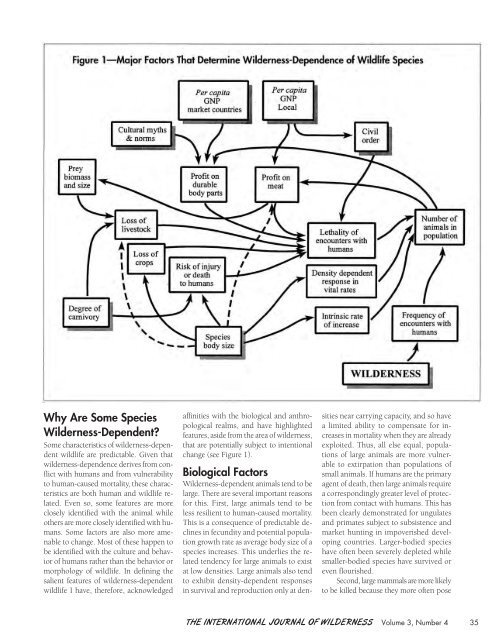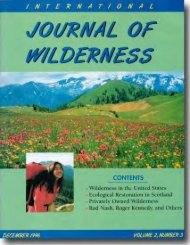Download full PDF - International Journal of Wilderness
Download full PDF - International Journal of Wilderness
Download full PDF - International Journal of Wilderness
Create successful ePaper yourself
Turn your PDF publications into a flip-book with our unique Google optimized e-Paper software.
Why Are Some Species<br />
<strong>Wilderness</strong>-Dependent?<br />
Some characteristics <strong>of</strong> wilderness-dependent<br />
wildlife are predictable. Given that<br />
wilderness-dependence derives from conflict<br />
with humans and from vulnerability<br />
to human-caused mortality, these characteristics<br />
are both human and wildlife related.<br />
Even so, some features are more<br />
closely identified with the animal while<br />
others are more closely identified with humans.<br />
Some factors are also more amenable<br />
to change. Most <strong>of</strong> these happen to<br />
be identified with the culture and behavior<br />
<strong>of</strong> humans rather than the behavior or<br />
morphology <strong>of</strong> wildlife. In defining the<br />
salient features <strong>of</strong> wilderness-dependent<br />
wildlife I have, therefore, acknowledged<br />
affinities with the biological and anthropological<br />
realms, and have highlighted<br />
features, aside from the area <strong>of</strong> wilderness,<br />
that are potentially subject to intentional<br />
change (see Figure 1).<br />
Biological Factors<br />
<strong>Wilderness</strong>-dependent animals tend to be<br />
large. There are several important reasons<br />
for this. First, large animals tend to be<br />
less resilient to human-caused mortality.<br />
This is a consequence <strong>of</strong> predictable declines<br />
in fecundity and potential population<br />
growth rate as average body size <strong>of</strong> a<br />
species increases. This underlies the related<br />
tendency for large animals to exist<br />
at low densities. Large animals also tend<br />
to exhibit density-dependent responses<br />
in survival and reproduction only at den-<br />
sities near carrying capacity, and so have<br />
a limited ability to compensate for increases<br />
in mortality when they are already<br />
exploited. Thus, all else equal, populations<br />
<strong>of</strong> large animals are more vulnerable<br />
to extirpation than populations <strong>of</strong><br />
small animals. If humans are the primary<br />
agent <strong>of</strong> death, then large animals require<br />
a correspondingly greater level <strong>of</strong> protection<br />
from contact with humans. This has<br />
been clearly demonstrated for ungulates<br />
and primates subject to subsistence and<br />
market hunting in impoverished developing<br />
countries. Larger-bodied species<br />
have <strong>of</strong>ten been severely depleted while<br />
smaller-bodied species have survived or<br />
even flourished.<br />
Second, large mammals are more likely<br />
to be killed because they more <strong>of</strong>ten pose<br />
THE INTERNATIONAL JOURNAL OF WILDERNESS Volume 3, Number 4 35










